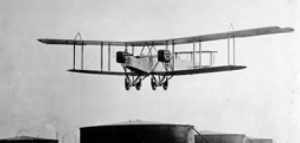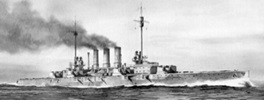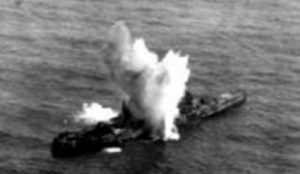By Marty Maisel
Challenging the Navy

USAF
Billy Mitchell continued to irritate his superior officers and Navy brass by testifying before Congressional committees that aircraft would make the Navy ineffective with statements such as “A few Army pilots could destroy the most powerful Naval fleet afloat,” “Advancements in aerial warfare would one day render the battleship obsolete,” and “One thousand bombardment airplanes can be built and operated for about the price of one battleship.”
The Navy, feeling pressure from Congress and the public to prove that airplanes could not sink its ships, agreed to have Mitchell participate in the 1921 Army/Navy war games in hope that Mitchell’s claims would be found to be wrong.
Under the Treaty that ended the Great War, confiscated German warships were to be destroyed. President Wilson set the deadline for destruction at July 24, 1921 – a date that was rapidly approaching.
The Navy provided four classes of German ships for the tests:
- submarine U-117 at 1,200 tons
- destroyer G-102 at 1,250 tons
- the light cruiser Frankfurt at 5,180 tons
- the battleship Ostfriesland at 27,000 tons
The tests would be in the waters off the Virginia capes and the Navy would set the rules of the Games. Military and civilian dignitaries observing the bombing test included the Secretary of the Navy, the Secretary of the War Dept., Congressmen, and representatives from Europe and Asia.
Mitchell set up Army operations at Langley Field, Hampton, Virginia and acquired nearly 200 Army aircraft and about 1000 men. The unit was designated the First Provisional Air Brigade. Mitchell’s team constructed a target practice “battleship” and designed and built 1000 lb and 2000 lb bombs, the largest aerial bombs built to date. In addition new bomb-sights were developed and his aircraft were modified with bomb racks. Also, Mitchell discovered from earlier secret Navy tests (conducted by Capt. Chester Nimitz) that near-misses are more effective than direct hits so he instructed his pilots to deliver their bombs alongside the ships to damage their hulls.

Naval Aircraft Factory F-5-L (U.S. National
Archives image is in the public domain)

de Havilland DH-4. (U.S. Army image is in the
public domain)

Handley-Page O/400 heavy bomber. (USAF image
is in the public domain)

German WWI battleship Ostfriesland (Image is in
the public domain)

The Ostfriesland sank twenty minutes after this bomb
hit. (U.S. Army image is in the public domain)
It is interesting to note the comments of one of the observers to the sinking of the Ostfriesland reported in the Hartford Courant newspaper:
“……It would be gravely embarrassing to the American people if the ideas of your General Mitchell were more appreciated in Japan than in the United States.”
“……you may be sure, we will study his experiments.”
The observer was G. Katsuda from Japan.
While no direct connection to the sinking of the Ostfriesland was found, in September 1921 the Navy Department established the Bureau of Aeronautics, under its Chief, Rear Admiral W. A. Moffett. Furthermore, in March 1922, the Navy commissioned its first aircraft carrier, the USS
Langley. In July 1922 Congress authorized building two additional aircraft carriers, the Lexington and the Saratoga, by converting unfinished battle cruisers.
